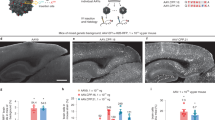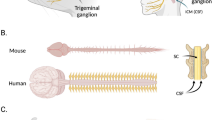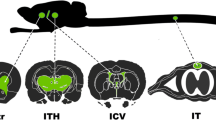Abstract
High doses of adenotk were injected into the cerebrospinal fluid of rats and nonhuman primates (Macaca mulatta). Vector administration was followed by ganciclovir administration for 14 days. Despite the absence of clinical symptoms, analysis of the cerebrospinal fluid (CSF) and histopathological examination of the central nervous system (CNS) of the monkeys (3 weeks after vector injection) were consistent with a viral meningitis. Immunohistochemical analysis of the inflammatory infiltrates in the monkeys revealed the presence of T and B lymphocytes, indicating a combined cellular and humoral immune response to the vector. This latter was supported by the finding of intrathecal anti-adenovirus antibody synthesis. Rats receiving high intrathecal adenotk doses showed a transient and dose-dependent clinical toxicity consisting of lethargy, hyperemic eyes and weight loss. Histopathological examination of the meninges showed a shift from polymorphonuclear infiltrates during the first post-injection days to clusters of mononuclear cells after 7 days. Acute toxicity is probably related to the early, innate immune response to the vector. In a separate experiment, high levels of IL-8 and IL-6, were measured during the first 2–3 post-injection days in the CSF of two monkeys which received intrathecal adenoLacZ. Therefore, these cytokines seem to play an important role in initiating the nonspecific immune response. In one monkey which received adenotk, recombinant adenovirus was cultured from serum samples obtained at the 7th post-injection day. At this time-point, no vector could be isolated from CSF samples. Based on these preclinical data, we recommend careful dose finding for clinical studies that aim to treat patients with leptomeningeal metastases.
This is a preview of subscription content, access via your institution
Access options
Subscribe to this journal
Receive 12 print issues and online access
$259.00 per year
only $21.58 per issue
Buy this article
- Purchase on Springer Link
- Instant access to full article PDF
Prices may be subject to local taxes which are calculated during checkout




Similar content being viewed by others
References
Posner JB . Leptomeningeal metastases. In: Neurologic Complications of Cancer FA Davis: Philadelphia 1995 pp 143–171
Vrionis FD et al. Tumor cells expressing the herpes simplex virus-thymidine kinase gene in the treatment of Walker 256 meningeal neoplasia in rats J Neurosurg 1996 84: 250–257
Ram Z et al. Intrathecal gene therapy for malignant leptomeningeal neoplasia Cancer Res 1994 54: 2141–2145
Kramm CM et al. Long-term survival in a rodent model of disseminated brain tumors by combined intrathecal delivery of herpes vectors and ganciclovir treatment Hum Gene Ther 1996 7: 1989–1994
Vincent AJPE et al. Treatment of leptomeningeal metastases in a rat model using a recombinant adenovirus containing the HSV-tk gene J Neurosurg 1996 85: 648–654
Oshiro EM et al. Toxicity studies and distribution dynamics of retroviral vectors following intrathecal administration of retroviral vector-producer cells Cancer Gene Ther 1995 2: 87–95
Morral N et al. Immune responses to reporter proteins and high viral dose limit duration of expression with adenoviral vectors: comparison of E2a wild type and E2a deleted vectors Hum Gene Ther 1997 8: 1275–1286
Driesse MJ et al. Distribution of recombinant adenovirus in the cerebrospinal fluid of nonhuman primates Hum Gene Ther 1999 10: 2347–2354
Ginsberg HS et al. A mouse model for investigating the molecular pathogenesis of adenovirus pneumonia Proc Natl Acad Sci USA 1991 88: 1651–1655
Cartmell T et al. Interkeukin-1 mediates a rapid inflammatory response after injection of adenoviral vectors into the brain J Neurosci 1999 19: 1517–1523
Amin A et al. Replication-deficient adenovirus induced expression of interleukin-8 by airway epithelial cells in vitro Hum Gene Ther 1995 6: 145–153
Bruder JT, Kovesdi I . Adenovirus infection stimulates the Raf/MAPK signaling pathways and induces interleukin-8 expression J Virol 1997 71: 398–404
Richter CB, Lehner NDM, Henrickson RV . Primates In: Fox JG, Cohen BJ, Loew FM (eds) Laboratory Animal Medicine Academic Press: New York 1984 p306
Kennedy CR et al. A major role for viruses in acute childhood encephalopathy Lancet 1986 1: 989–991
Adesanya MR, Redman RS, Baum BJ, O'Connell BC . Immediate inflammatory responses to adenovirus-mediated gene transfer in rat salivary glands Hum Gene Ther 1996 7: 1085–1093
Worgall S, Wolff G, Falck-Pedersen E, Crystal RG . Innate immune mechanisms dominate elimination of adenoviral vectors following in vivo administration Hum Gene Ther 1997 8: 37–44
Otake K, Ennist DL, Harrod K, Trapnell BC . Nonspecific inflammation inhibits adenovirus-mediated pulmonary gene transfer and expression independent of specific acquired immune responses Hum Gene Ther 1998 9: 2207–2222
Byrnes AP, Rusby JE, Wood MJA, Charlton HM . Adenovirus gene transfer causes inflammation in the brain Neuroscience 1995 66: 1015–1024
Hermens WTJMC, Verhaagen J . Adenoviral vector-mediated gene transfer in immuno competent Wister rats and T-cell deficient nude rats: preferential survival of transduced glial cells in nude rats Hum Gene Ther 1997 8: 1049–1063
Crystal RG et al. Administration of an adenovirus containing the human CFTR cDNA to the respiratory tract of individuals with cystic fibrosis Nat Genet 1994 8: 42–51
Yang Y et al. Cellular immunity to viral antigens limits E1-deleted adenoviruses for gene therapy Proc Natl Acad Sci USA 1994 91: 4407–4411
Yang Y, Li Q, Ertl HC, Wilson JM . Cellular and humoral immune responses to viral antigens create barriers to lung-directed gene therapy with recombinant adenoviruses J Virol 1995 69: 2004–2015
Tripathy SK, Black HB, Goldwasser E, Leiden JM . Immune responses to transgene-encoded proteins limit the stability of gene expression after injection of replication-defective adenovirus vectors Nature Med 1996 2: 545–550
Russi TJ, Hirschowitz EA, Crystal RG . Delayed-type hypersensitivity response to high dose of adenoviral vectors Hum Gene Ther 1997 8: 323–330
Song W, Kong H-L, Traktman P, Crystal RG . Cytotoxic T lymphocyte responses to proteins encoded by heterologous transgenes transferred in vivo by adenoviral vectors Hum Gene Ther 1997 8: 1207–1217
Byrnes AP, MacLaren RE, Charlton HM . Immunological instability of persistent adenovirus vectors in the brain: peripheral exposure to vector leads to renewed inflammation, reduced gene expression, and demyelination J Neurosci 1996 16: 3045–3055
Kafri T et al. Cellular immune response to adenoviral vector infected cells does not require de novo viral gene expression: implications for gene therapy Proc Natl Acad Sci USA 1998 95: 11377–11382
Gordon LB, Knopf PM, Cserr HF . Ovalbumin is more immunogenic when introduced into brain or cerebrospinal fluid than into extracerebral sites J Neuroimmunol 1992 40: 81–88
Cserr HF et al. Afferent and efferent arms of the humoral immune response to CSF-administered albumins in a rat model with normal blood–brain barrier permeability J Neuroimmunol 1992 41: 195–202
Cserr HF, Knopf PM . Cervical lymphatics, the blood–brain barrier and immunoreactivity of the brain: a new view Immunol Today 1992 13: 507–512
Fabry Z, Raine CS, Hart MN . Nervous tissue as an immune compartment: the dialect of the immune response in the CNS Immunol Today 1994 15: 218–224
Stevenson PG, Hawke S, Sloan DJ, Bangham RM . The immunogenicity of intracerebral virus infection depends on anatomical site J Virol 1997 71: 145–151
Knopf PM et al. Antigen-dependent intrathecal antibody synthesis in the normal rat brain: tissue entry and local retention of antigen-specific B cells J Immunol 1998 161: 692–701
Dewey RA et al. Chronic brain inflammation and persistent herpes simplex virus 1 thymidine kinase expression in survivors of syngeneic glioma treated by adenovirus-mediated gene therapy: implications for clinical trials Nature Med 1999 5: 1256–1263
Spergel JM, Chen-Kiang S . Interleukin 6 enhances a cellular activity that functionally substitutes for E1A protein in transactivation Proc Natl Acad Sci USA 1991 88: 6472–6476
Vincent AJPE et al. Herpes simplex virus thymidine kinase gene therapy for rat malignant brain tumors Hum Gene Ther 1996 7: 197–205
Precious B, Russel W . Growth, purification and titration of adenoviruses. In: Mahy B (ed) Virology: A Practical Approach Raven Press: New York 1985 pp 157–167
Fallaux FJ et al. Characterization of 911: a new helper cell-line for the titration and propagation of early region-1 deleted adenoviral vectors Hum Gene Ther 1996 7: 215–222
Bout A et al. In vivo adenovirus-mediated transfer of human CFTR cDNA to rhesus monkey airway epithelium: efficacy, toxicity and safety Gene Therapy 1994 1: 385–394
De Jong JC et al. Detection, typing and subtyping of enteric adenoviruses 40 and 41 from fecal samples and observation of changing incidences of infections with these types and subtypes J Clin Microbiol 1993 31: 1562–1569
Snider R, Lee J . A Stereotactic Atlas of the Monkey Brain (Macaca mulatta) University of Chicago Press: Chicago, London 1961
McCully CL et al. A rhesus monkey model for continuous infusion of drugs into cerebrospinal fluid Lab An Sci 1990 40: 520–525
Fishman RA . Cerebrospinal fluid in diseases of the nervous system, (2nd edn.) WB Saunders Co: Philadelphia 1992
Acknowledgements
We thank J van Loon for the careful preparation of the histological sections. We are grateful to P van Eerd, H Koning and E Kuhn for their assistance in animal care and necropsies. This work was supported by the Nederlandse Hersenstichting.
Author information
Authors and Affiliations
Rights and permissions
About this article
Cite this article
Driesse, M., Esandi, M., Kros, J. et al. Intra-CSF administered recombinant adenovirus causes an immune response-mediated toxicity. Gene Ther 7, 1401–1409 (2000). https://doi.org/10.1038/sj.gt.3301250
Received:
Accepted:
Published:
Issue Date:
DOI: https://doi.org/10.1038/sj.gt.3301250
Keywords
This article is cited by
-
Oncolytic HSV1 targets different growth phases of breast cancer leptomeningeal metastases
Cancer Gene Therapy (2023)
-
Identification and characterization of human nucleus pulposus cell specific serotypes of adeno-associated virus for gene therapeutic approaches of intervertebral disc disorders
BMC Musculoskeletal Disorders (2015)
-
Local sustained delivery of oncolytic adenovirus with injectable alginate gel for cancer virotherapy
Gene Therapy (2013)
-
Truncating the i-leader open reading frame enhances release of human adenovirus type 5 in glioma cells
Virology Journal (2011)
-
A technique for intracisternal collection and administration in a rhesus macaque
Lab Animal (2010)



